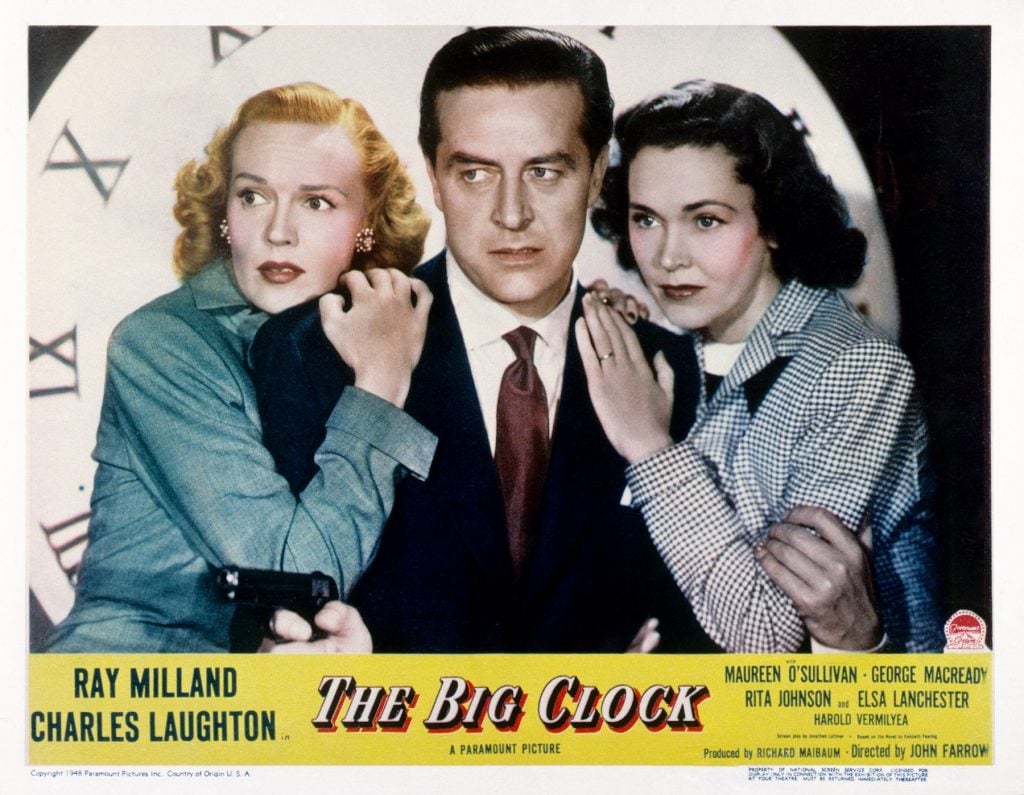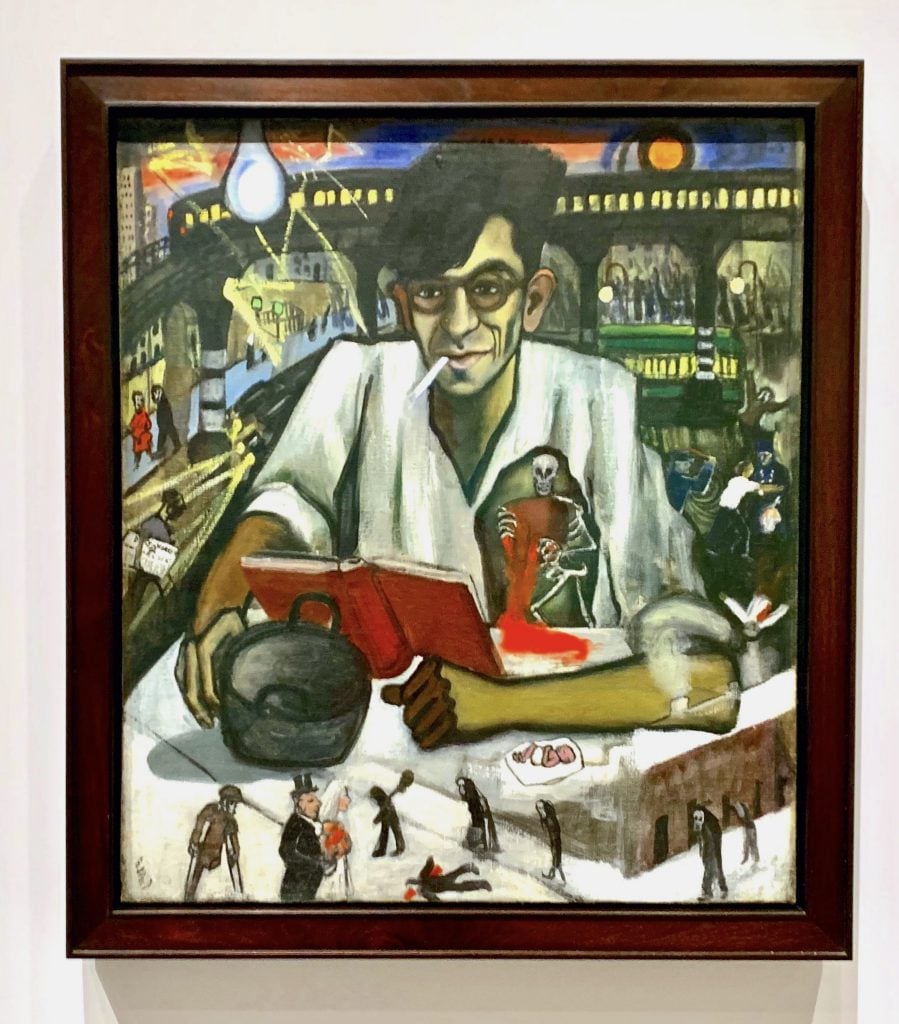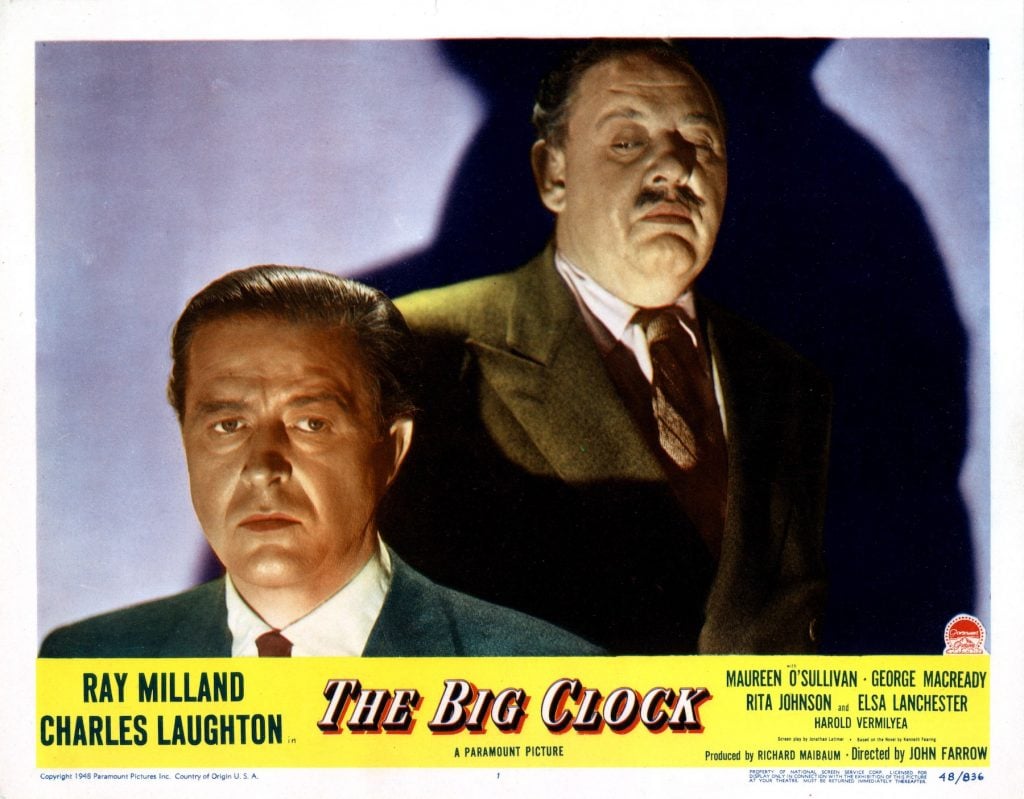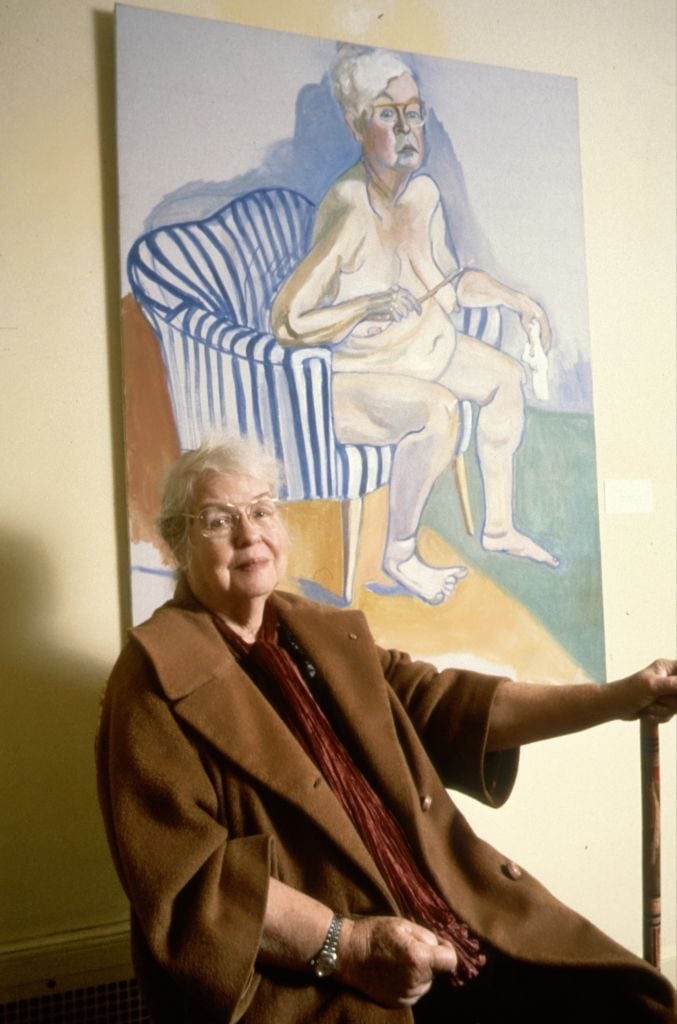Art History
How Much of a Character Was Alice Neel? Just Look at ‘The Big Clock,’ the Classic Film Noir Partly Based on the Artist’s Notoriety
The painter's bohemian ways inspired a key character in the hit 1948 movie.

The painter's bohemian ways inspired a key character in the hit 1948 movie.

Ben Davis

Alice Neel has a fascinatingly eccentric place in pop culture. A few years ago, I did a bunch of research to review her show at the Metropolitan Museum, but you don’t always get to use all the interesting stuff you find. With a big Neel show attracting notice at the Barbican in London, I thought maybe now was a good time to dig into the curious case of Alice Neel’s presence in film.
Neel cut her teeth working in the WPA in the ‘30s, remained committed to her idiosyncratic style of realist painting and leftist philosophy through decades of living in obscurity, and was brought back to notoriety when she was championed by feminist artists in the 1970s. She’s been highly regarded ever since.
But here’s what fascinates me: Even at the lowest ebb of her popularity, in the McCarthyite period post-WWII, when Neel’s bohemian ways, Communist affiliations, and yen for figuration made her persona non grata in the mainstream art world, she was still an irresistible character. In fact, she was such a character that even when her art was near unshowable, she herself was still a presence in culture—a status that preceded her rediscovery by some time.
If you want to see what I mean, go watch The Big Clock, the 1948 film noir classic.
The film is directed by John Farrow (father of Mia), based on a crime novel by Kenneth Fearing, from 1946. Fearing, quite a character himself, was considered the progenitor of the genre of “proletarian poetry,” had similar political sympathies to Neel, and was steeped in the same New York milieu.
Neel painted Fearing in 1935, in a symbolist mode, featuring the poet with a book open before him and a cigarette in his mouth, beaming out at the viewer in thick glasses. All around him is a landscape populated by tiny figures acting out the social injustices of the time. Most notably, Fearing’s chest is split open and a tiny demon skeleton is shown squeezing at his heart. He supposedly did not love the skeleton when he saw it and told Neel to excise it, though Neel’s intention, she said later, was to show that Fearing’s “heart bled for the grief of the world.”

Alice Neel’s Kenneth Fearing (1935) at the Metropolitan Museum. Photo by Ben Davis.
The poet later returned the gift of ambiguous tribute by including the character of “Louise Patterson,” a tough bohemian painter obviously based on Neel, in his novel The Big Clock. Fearing had worked for six months at Time, part of the Henry Luce media empire, and the plot encoded his criticism of the industry, involving the mogul Earl Janoth of the fictitious Janoth media empire killing his mistress, then covering it up.
The great twist is that the mogul gets his underling George Stroud, editor of Crimeways magazine, to lead the effort to hunt down the other man his mistress was with the night of her death, to pin the murder on him—not knowing that that other man is Stroud himself. The satisfyingly knotty tale thus ends up with Stroud both carrying out an investigation and trying to sabotage it from within.
When cultural historians talk about a submerged Marxism within the noir genre, and how noir’s indirect subject matter is often anti-Communist panic, The Big Clock is a star exhibit—it’s about a perverse witch hunt. (The story was remade as the Reagan-era Kevin Costner spy thriller No Way Out, while the film’s climax amid the immense clock mechanism at the top of the Janoth skyscraper inspired the Coen Brothers’ clocktower set piece in The Hudsucker Proxy.)

Poster for The Big Clock. Left to right: Ray Milland, Charles Laughton, 1948. (Photo by LMPC via Getty Images)
In Fearing’s novel, the Patterson character comes into play because Stroud had purchased a painting by her in a junk store on the night of the crime; the artist had run into him buying it—she had been trying to buy back her own painting herself—and her ability to identify him makes her important to the hunt.
Fearing describes Patterson’s style of figurative painting as having qualities of “simplified abstractionism and fresh intensifications of color” that well describe Neel’s look. More tellingly, when you read the Stroud character’s internal monologue, it definitely sounds as if he is reflecting on Neel’s status in the 1940s:
It was the literal truth that I did not myself know what a Patterson would be worth, today, on the regular market. Nothing fabulous, I knew; but on the other hand, although Patterson hadn’t exhibited for years, and for all I knew was dead, it did not seem possible her work had passed into complete eclipse. The things I had picked up for a few hundred had been bargains when I bought them, and later still the artist’s canvases had brought much more, though only for a time.
According to Phoebe Hoban’s biography Alice Neel: The Art of Not Sitting Pretty, the junk shop scene was inspired by a real incident where Neel had to buy back her own WPA paintings after they were sold off by the government and found their way to a Greenwich Village second-hand store. (An article about the government art sell-off appeared when Fearing was starting his novel in an April 1944 issue of Life magazine, another Luce publication. It was illustrated by a Neel painting.)
As described in Fearing’s novel, Patterson is proudly unconventional, hard-drinking, sarcastic, and hides her vulnerabilities behind deliberately provoking the squares around her. “I’ve never been married,” she tells an investigator who asks where the father of her four children are, shocking him. “They’re all LOVE children, Mr. Klausmeyer.” She comes off, in other words, as a real character.
![Elsa Lanchester [left] plays Louise Patterson, a painter based on Alice Neel in The Big Clock](https://news.artnet.com/app/news-upload/2023/05/the-big-clock-1024x733.jpg)
Elsa Lanchester [left] plays Louise Patterson, a painter based on Alice Neel in The Big Clock (1948) (Photo by FilmPublicityArchive/United Archives via Getty Images)
Between the publication of Fearing’s novel in 1946 and the release of Farrow’s film in 1948, president Truman signed Executive Order 9835, designed to root out communists in government, and the House Un-American Affairs Committee (HUAC) was coming into high season. The kind of left-wing politics which had been very much mainstream among artists of all kinds in the New Deal era, which had provided the early audience for both Neel and Fearing, could get you fired or ostracized.
Knowing that history and their biographies, the status of the Patterson character in Fearing’s story is actually poignant.
The Big Clock is about a man whose life of middle-class normalcy is shattered by a false accusation. The painter character—free-spirited, impoverished, and defiantly living outside of the conventions of respectability—represents a cultural world that could incriminate you if you ended up associated with it even unknowingly. The fact that Patterson potentially threatens to reveal George Stroud’s face in her art cyphers anxiety about former comrades “naming names.” (When Fearing himself was called in front of HUAC, in 1950, to answer the question of whether he had been a member of the Communist Party, he answered with calculated irony, “Not yet.”)

Alice Neel circa 1980 in New York. Photo by Sonia Moskowitz/Images/Getty Images.
I haven’t been able to find what Alice Neel’s thoughts on the book or the film were. I see that in his official biography, Fearing, an alcoholic, is said to have confided in Neel that the financial success of The Big Clock had made it harder to get work done, since he could afford to start drinking in the morning.
Farrow’s thriller is actually not the only time Alice Neel appears in fiction. There is also that time that Susan Sarandon played her in the indie film Joe Gould’s Secret, Stanley Tucci’s forgotten directorial follow-up to Big Night. A more flattering portrayal, but less extraordinary in that it comes from after Neel’s return to fame. And a story for another time….